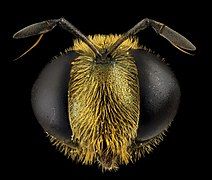Муравьиные журчалки
| Муравьиные журчалки | ||||||||||
|---|---|---|---|---|---|---|---|---|---|---|
 Microdon analis | ||||||||||
| Научная классификация | ||||||||||
|
Домен: Царство: Подцарство: Без ранга: Без ранга: Без ранга: Без ранга: Тип: Подтип: Надкласс: Класс: Подкласс: Инфракласс: Надотряд: Отряд: Подотряд: Инфраотряд: Секция: Надсемейство: Семейство: Подсемейство: Род: Муравьиные журчалки |
||||||||||
| Международное научное название | ||||||||||
| Microdon Meigen, 1803 | ||||||||||
| Типовой вид | ||||||||||
|
Musca mutabilis Linnaeus, 1758 |
||||||||||
| Подроды | ||||||||||
|
||||||||||
| ||||||||||
Муравьиные журчалки[1] (лат. Microdon) — род мух-журчалок из подсемейства Microdontinae.
Описание
[править | править код]Мухи средних и крупных размеров[2], обычно в длину бывают 8—15 мм. Тело коренастое. Щиток имеет одну пару апикальных бугорков или зубцов. Брюшко сильно выпуклое. R4+5 образует отросток в ячейке r5[2].
Личинки мух обладают необычной формой, напоминая слизней, отчего их иногда описывали как моллюсков[3].
Экология и местообитания
[править | править код]Личинки этих мух живут глубоко в муравейниках[4][5][6]. Некоторые из видов питаются куколками[2][3] муравьёв, другие детритофаги.
Галерея
[править | править код]-
Личинка Microdon
-
Голова Microdon
Виды
[править | править код]Род насчитывает около 380 видов[7], некоторые из них:
- Microdon abditus Thompson, 1981[8]
- Microdon abstrusus Thompson, 1981[8]
- Microdon adventitius Thompson, 1981[8]
- Microdon albicomatus Novak, 1977
- Microdon analis (Macquart, 1981)[9]
- MMicrodon aurulentus (Fabricius, 1805)
- Microdon baliopterus Loew, 1872
- Microdon brunetti Sodhi & Singh, 1991[10]
- Microdon carolae (Capelle, 1956)
- Microdon coarctatus Loew, 1864
- Microdon cothurnatus Bigot, 1883
- Microdon devius (Linnaeus, 1761)[9]
- Microdon diversipilosus Curran, 1925
- Microdon eggeri Mik, 1897[11]
- Microdon fulgens Wiedemann, 1830
- Microdon fuscipennis (Macquart, 1834)[3]
- Microdon globosus (Fabricius, 1805)
- Microdon ignotus Violovitsh, 1976
- Microdon katsurai Maruyama & Hironaga, 2004[12]
- Microdon laetoides Curran, 1935
- Microdon laetus Loew, 1864
- Microdon lanceolatus Adams, 1903
- Microdon lateus Violovitsh, 1976[11]
- Microdon latifrons Loew, 1856[11]
- Microdon manitobensis Curran, 1924
- Microdon maritimus Violovitsh, 1976[11]
- Microdon marmoratum Bigot, 1883
- Microdon megalogaster Snow, 1892
- Microdon miki Doczkal & Schmid, 1999
- Microdon mutabilis (Linnaeus, 1758) typus[7][9]
- Microdon myrmicae Schönrogge et al., 2002
- Microdon mysa Violovitsh Violovitsh, 1971[11]
- Microdon newcomeri Mann, 1924
- Microdon ocellaris Curran, 1924
- Microdon painteri Hull, 1922
- Microdon pallipennis Curran, 19245
- Microdon piperi Knab, 1917
- Microdon ruficrus Williston, 1887
- Microdon rufipes (Macquart, 1842)
- Microdon sophianus Drensky, 1934
- Microdon stuckenbergi Keiser, 1971[7]
- Microdon tristis Loew, 1864
- Microdon ursitarsis Stackelberg, 1926[11]
- Microdon viridis Townsend, 1895
- Microdon xanthopilis Townsend, 1895
Примечания
[править | править код]- ↑ Стриганова Б. Р., Захаров А. А. Пятиязычный словарь названий животных: Насекомые. Латинский, русский, английский, немецкий, французский / под ред. д-ра биол. наук, проф. Б. Р. Стригановой. — М.: РУССО, 2000. — С. 323. — 1060 экз. — ISBN 5-88721-162-8.
- ↑ 1 2 3 Определитель насекомых Дальнего Востока СССР. Двукрылые и блохи / Лер П. А.. — Владивосток: «Дальнаука», 1999. — Т. VI (1). — С. 359. — 664 с. — ISBN 5-7442-0921-2.
- ↑ 1 2 3 Duffield, R.M. Biology of Microdon fuscipennis (Diptera: Syrphidae) with interpretation of reproductive strategies of Microdon species found north of Mexico (англ.) // Proceedings of the Entomological Society of Washington : journal. — Washington D.C.: Allen Press, 1981. — Vol. 83. — P. 716—724.. — ISSN 0013-8797.
- ↑ Witek, M., Patricelli, D., Pietro Casacci, L., Barbero, F., Balletto, E. & Bonelli, S. (2011) Notes on the biology and host ant specificity of the myrmecophilous syrphid fly Microdon major (Diptera: Syrphidae), a social parasite of Formica ants (Hymenoptera: Formicidae). Sociobiology, 57 (2), 261–269.
- ↑ Wolton, R. (2011) Observations on ecology and behaviour of Microdon myrmicae Schönrogge et al. (Diptera, Syrphidae), with a description of egg and early instar morphology. Dipterists Digest, 18, 55–67.
- ↑ Wheeler, W.M. (1908) Studies on myrmecophiles. III. Microdon. Journal of the New York Entomological Society, 16, 202–213.
- ↑ 1 2 3 Reemer Menno, Gunilla Ståhls. (2013). Generic revision and species classification of the Microdontinae (Diptera, Syrphidae). Архивная копия от 1 августа 2014 на Wayback Machine — ZooKeys 287: 1—213, doi: 10.3897/zookeys.287.4095
- ↑ 1 2 3 Thompson, F.C. Revisionary notes on Nearctic Microdon flies (Diptera: Syrphidae) (англ.) // Proceedings of the Entomological Society of Washington : journal. — Washington D.C.: Allen Press, 1981. — Vol. 83. — P. 725—758. — ISSN 0013-8797.
- ↑ 1 2 3 Stubbs, Alan E. and Falk, Steven J. British Hoverflies: An Illustrated Identification Guide (англ.). — British Entomological & Natural History Society, 1983. — P. 253, xvpp.
- ↑ Sodhi N. S.б Singh A. Three new species of family Syrphidae (Diptera) from India (англ.) // Acta zoologica cracoviensia : journal. — 1991. — Vol. 34, no. 1. — P. 315—322.
- ↑ 1 2 3 4 5 6 Barkalov, A.V. Syrphidae collection of Siberian Zoological Museum. Novosibirsk, Russia: the Institute of Animal Systematics and Ecology, Siberian Branch of the Russian Academy of Sciences. Дата обращения: 17 августа 2009. Архивировано 5 марта 2016 года.
- ↑ Maruyama, Munetoshi; Hironaga, Teruhiko. Microdon katsurai, a New Species of Myrmecophilous Hoverfly (Diptera, Syrphidae) from Japan, Associated with Polyrhachis lamellidens (Hymenoptera, Formicidae) (англ.) // Bulletin of the National Science Museum : journal. — Tokyo: National Science Museum, Tokyo, 2004. — 22 December (vol. A, no. 4). — P. 173—179. (недоступная ссылка)
Литература
[править | править код]- Scarparo G. et al., 2020. Comparative morphology of myrmecophilous immature stages of European Microdon species (Diptera: Syrphidae): updated identification key and new diagnostic characters. Zootaxa Vol 4789, No 2: 348—370. http://dx.doi.org/10.11646/zootaxa.4789.2.2

